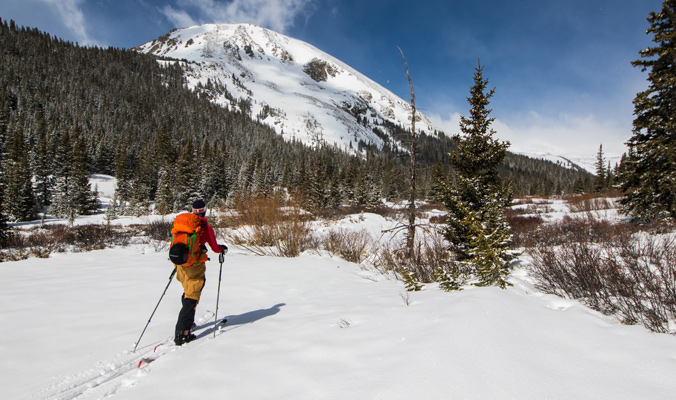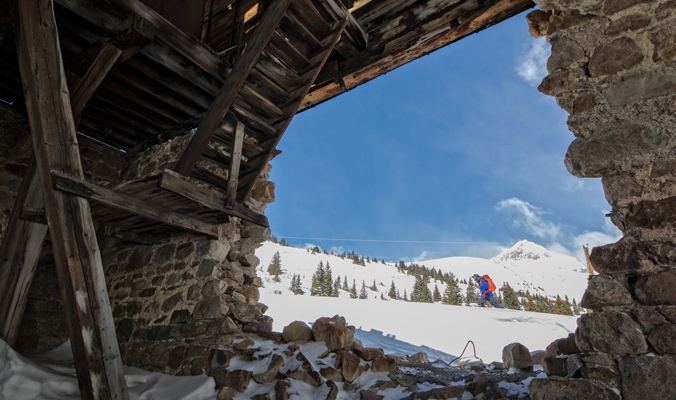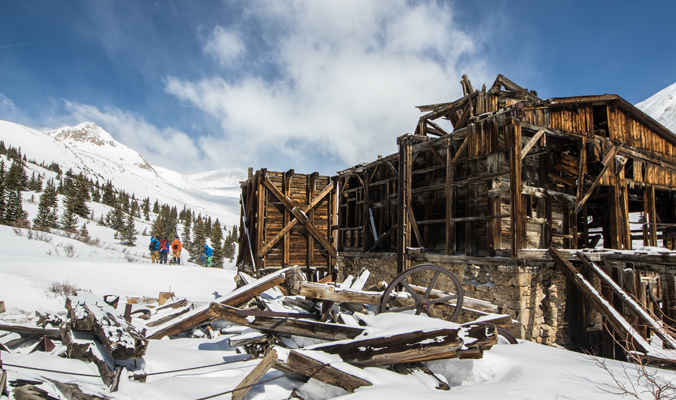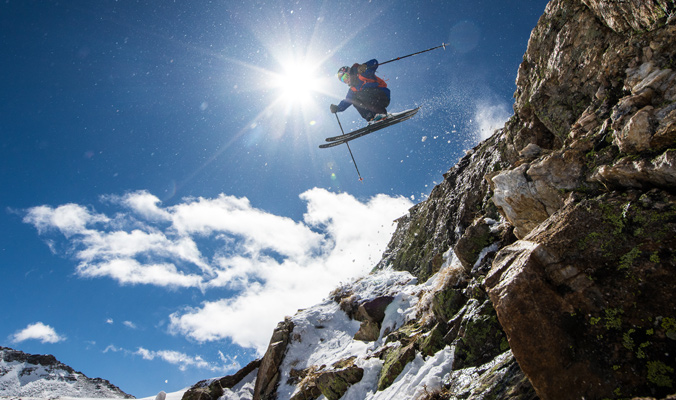Leaning into the 40-degree slope, I look up as Fritz Sperry, our guide for the next couple days, sets a bootpack up one of the countless alpine faces surrounding Colorado’s Mosquito Pass. “I did not think we would be getting this line today,” he says, kicking steps into a seemingly endless staircase.

Cold Rush: The author heads up Mosquito Gulch [Photo] Liam Doran
“None of us did,” I respond, thinking back a couple of hours. That’s when whiteout conditions enveloped Alma, a quiet town of 280 residents 17 miles south of Breckenridge. It’s also the eastern terminus of the 16-mile, unmaintained dirt road that crests the Mosquito Range at 13,185 feet en route to Leadville. And on Mosquito Pass, Jeff Crane, who stands beside me on this 2,000-foot face, is masterminding a project to promote access to the imposing peaks stacked all around with an accessible, 10th-Mountain-Division-style hut offering.
Jeff Crane grew up in Denver, but left for college and ended up in upstate New York, where he lives today. He jokes that he moved East to become a better skier, but he gets serious when speaking about his Mosquito Pass dreams. “I’m 49 years old,” he says, “and I’ve been kinda thinking [that since] I started in Colorado, I might like to finish here and see this as a way to get back.”
The idea for a hut system on Mosquito Pass emerged after a summer hike in 2016 where the terrain awed Crane, and his mind latched onto what skiing possibilities might exist if accommodations were available. Back in town he made a few phone calls that led to Joe Harrington, who owns 3,000 acres spanning most of the pass’s Alma side, including the abandoned North London mine. Harrington’s business, Minewater LLC, specializes in cleaning up old mining sites, which they’ve already done on the pass and, therefore, Harrington wasn’t doing anything with the land. So when he heard Crane’s idea for the area, he immediately got on board.

Jacob O’Connor strikes gold on London Mountain’s wave. [Photo] Liam Doran
Over the following months, Crane and his partner, Kate McCoy, formed an LLC that morphed into North London Mill Preservations Inc., the nonprofit that will be behind the Mosquito Pass Backcountry Experience. Jeff aims to preserve the history of the North London Mine by turning the abandoned buildings into usable infrastructure. With the right grants and funding, they plan to start work this summer.
I look down our east-facing line, a wide swath of dust on crust framed by loose rock walls. The upper portion is a sustained 40 degrees, with the angle diminishing lower down, where islands of black rock thrust through the late-season snowpack. Below that, four buildings left behind from the North London Mine dot the valley floor.
“When it was operating, there were probably around 1,000 people working or living up here,” Crane says. But after one of Colorado’s biggest gold strikes, which spanned 70 years and resulted in nearly one million ounces of gold, the mine closed during WWII, and the buildings were abandoned. Some have fared better than others, and those most intact are giving Crane something to work with.
Despite the mining history and proximity to Breckenridge, there is little information about this zone beyond what’s published in Fritz Sperry’s 2012 guidebook, Making Turns in the Tenmile – Mosquito Range. Breck absorbs most of the area’s ski traffic, leaving the Mosquito Range close to trackless.
Sperry says the line to our right as we climb, named The Wave, is the iconic descent for the area, curving between two rock walls off the summit and dropping straight down from a large, wave-shaped cornice. The equally aesthetic line to looker’s left of The Wave, the one that we’re hiking, is called Jack the Ripper, and it seldom sees skis.

Jacob O’Connor finds out what all the buzz is about outside of Mosquito Pass, Colo.’s North London Mill. [Photo] Liam Doran
Etched into 13,194-foot London Mountain’s east face, the two ski lines are the first you see when driving by the pass. “London is the guardian of the valley,” Sperry says. “You get in for The Wave and then see what else the zone has to offer, [and it’s] like, ‘Whoa.’”
“Whoa” is an understatement. Directly across from us sits Loveland Mountain (13,692 ft.), its entire west face carved with 2,000-foot couloirs. Farther into the pass, five steep spines on Mt. Buckskin (13,872 ft.) beckon. From Buckskin, the mountains curl around, opening into a massive bowl that Sperry calls Treasure Vault, packed with low-angle 800-foot bowls and 1,500-foot steeps.
The dust-on-crust conditions crunch beneath my board as I drop into the line. I slip and catch, then gracelessly whip my body around to repeat the process. After a few turns, muscle memory takes over, and I carve down the face as the crust gives way to edgeable conditions with just enough fresh snow to award moments of float between turns. Near the bottom, we almost managed to ski to the office of the old mine in the valley’s center.
The square building, which seems large enough to house 10 people in close quarters, is Crane’s first project. “We are kind of just picking the low-hanging fruit with the North London [mining] office,” he says. “Amazingly, it’s already zoned so that we could use it. One of the uses is as a bed and breakfast.”

A sight for sore eyes or an opportunity in the making? The North London Mill sits idle in front of Mt. Tweto. [Photo] Liam Doran
He plans to refurbish the building into a hut with accommodations similar to those of the 10th Mountain Division system: a kitchen and open living space, along with five bedrooms, three with queen-size beds and two with two bunks apiece. The office may even have electricity, which still runs past the site, a leftover from the mine’s heyday.
Crane has been in talks with the architect who worked to preserve the integrity of the Paris Mill, another nearby abandoned mine that has been turned into a historical landmark and museum. “We like this because [the office] will be living,” he says. “This has a chance of being a living monument of something.”
The office needs a lot of work, though. When Crane says it’s “ski in, ski out,” he’s not joking. The building is still standing, but there’s at least one hole that’s large enough to skin through, and the interior needs to be all but gutted. He’s already had the site surveyed and recognized as a historical landmark in Park County, opening up several funding options, including opportunities through History Colorado—the state historic fund—and the Gates Family Foundation, where they have applied for a combined budget of $281,000.
From the office it’s a short skin to what was once North London’s mill, a building that, if the office were a hut, would be a backcountry mansion. It towers before us, rising three stories, the staircase visible from top to bottom through a missing wall, as if a cross-section had been cut away. It looks like it could collapse at any moment. Nonetheless, my imagination runs wild with the possibilities that a structure like this could offer. Crane’s already done plenty of dreaming and believes the mill has the potential to set his planned hut system apart from others.

Jacob O’Connor stakes his claim off Oliver Twist beneath Mosquito Pass. [Photo] Liam Doran
“I think we have to see how popular and viable the office ends up being and then what the mill looks like after we’ve thrown some money at it,” he says. “I’ve imagined building into it and keeping it a ruin in a way, but a stabilized ruin that has a roof over it.” Crane also has his eyes set on a third structure for a separate sauna and bathhouse, for hut guests and day users looking to soak after a day in the mountains.
A soak and a beer sound pretty good to me right now, but with nowhere to enjoy either, we retire to South Park Saloon, Alma’s one bar. The outside looks straight out of a John Wayne movie, but inside is a cozy, bustling tavern where we pack into a corner table and discuss plans for tomorrow.
Clouds shroud town in the morning, but the overcast breaks as we drive into the pass. And while the surrounding mountains hold back the clouds, wind is funneled through the valley with such force that, when the area was considered for windmill placement years ago, surveyors deemed it too windy. This, combined with the area’s lack of trees and Colorado’s notoriously touchy snowpack, makes hitting the area in the right conditions a challenging pursuit.
“The biggest struggle is that you have such a high valley, so you don’t have long lines of trees to ski; you don’t have protected areas to ski,” Sperry says. The mill and office sit near 11,200 feet, essentially the boundary between tree line and the alpine.
The best of the tree lines lie behind the office, a 10-minute skin from the buildings. But it’s a small zone, only offering a few runs if it’s windy or when there’s avalanche danger. This doesn’t deter Crane, however. “There’s enough low-angle stuff that’s interesting,” he says. “And the thing is with hut trips, mostly you go [for] the hut; you’re at the hut.”
It’s certainly true that many people go on hut trips for the overall experience, and since the road is plowed to within two miles of the mine, the office is accessible to many types of recreationists. Besides, Sperry adds, “[In] most of Colorado, if you want to get up in the alpine, you do it in spring.”
“Generally speaking,” he continues, “the 14ers in this zone are pretty easy, but then when you get into the 13ers, you get some more interesting bits…. It’s the perfect place for people to do it the old-school way; in the winter you ski the trees and in spring you go for big-mountain lines.”
Sperry is clearly onto something. It’s also clear that Crane has an uphill battle in making this a regular destination. Not only will refurbishing the run-down buildings require a huge investment of time and money, but the windy conditions and lack of trees could make this area a hard sell when compared to nearby Breckenridge. But Crane has his sights set on making something happen here; he’s driven and ambitious, making friends and talking business whenever we’re in town. And Denver’s proximity—less than a two-hour drive—makes Mosquito Pass a close destination for a massive, adventure-seeking population.
As we skin toward our cars, I take one last look into the basin. Its stark beauty and harsh conditions give me premonitions of what’s to come. And I know that if Crane’s headstrong attitude persists, someday soon we could be heading to a warm hut instead of a cold car in this quiet, expansive setting.










Related posts:
The Skintrack to Environmental Activism: The David Brower Story
Giant’s Steps: A Brief History of an Infamous High Sierra Line